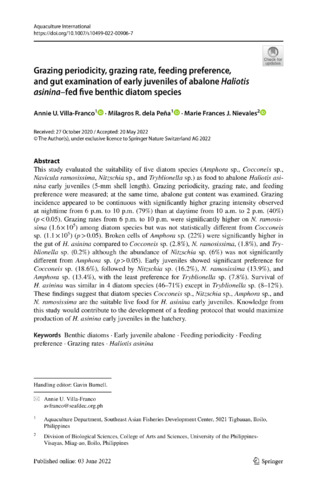Grazing periodicity, grazing rate, feeding preference, and gut examination of early juveniles of abalone Haliotis asinina–fed five benthic diatom species
- Global styles
- MLA
- Vancouver
- Elsevier - Harvard
- APA
- Help

閲覧/開く
日付
2022-06-03Page views
573ASFA keyword
AGROVOC keyword
Taxonomic term
Metadata
アイテムの詳細レコードを表示する
Share
抄録
This study evaluated the suitability of five diatom species (Amphora sp., Cocconeis sp., Navicula ramosissima, Nitzschia sp., and Tryblionella sp.) as food to abalone Haliotis asinina early juveniles (5-mm shell length). Grazing periodicity, grazing rate, and feeding preference were measured; at the same time, abalone gut content was examined. Grazing incidence appeared to be continuous with significantly higher grazing intensity observed at nighttime from 6 p.m. to 10 p.m. (79%) than at daytime from 10 a.m. to 2 p.m. (40%) (p < 0.05). Grazing rates from 6 p.m. to 10 p.m. were significantly higher on N. ramosissima (1.6 × 105) among diatom species but was not statistically different from Cocconeis sp. (1.1 × 105) (p > 0.05). Broken cells of Amphora sp. (22%) were significantly higher in the gut of H. asinina compared to Cocconeis sp. (2.8%), N. ramosissima, (1.8%), and Tryblionella sp. (0.2%) although the abundance of Nitzschia sp. (6%) was not significantly different from Amphora sp. (p > 0.05). Early juveniles showed significant preference for Cocconeis sp. (18.6%), followed by Nitzschia sp. (16.2%), N. ramosissima (13.9%), and Amphora sp. (13.4%), with the least preference for Tryblionella sp. (7.8%). Survival of H. asinina was similar in 4 diatom species (46–71%) except in Tryblionella sp. (8–12%). These findings suggest that diatom species Cocconeis sp., Nitzschia sp., Amphora sp., and N. ramosissima are the suitable live food for H. asinina early juveniles. Knowledge from this study would contribute to the development of a feeding protocol that would maximize production of H. asinina early juveniles in the hatchery.
Keywords
Benthic diatoms Early juvenile abalone Feeding periodicity Feeding preference Grazing ratesSuggested Citation
Villa-Franco, A., de la Peña, M. R., & Nievales, M. (2022). Grazing periodicity, grazing rate, feeding preference, and gut examination of early juveniles of abalone Haliotis asinina–fed five benthic diatom species. Aquaculture International , 30(5), 2343-2364. https://doi.org/10.1007/s10499-022-00906-7
Type
ArticleISSN
0967-6120; 1573-143XCollections
- Journal Articles [1256]
Related items
Showing items related by title, author, creator and subject.
-
Settlement, growth and survival of donkey's ear abalone Haliotis asinina (Linne) in response to diatom diets and attachment substrate
de la Peña, Milagros R.; Bautista, Joseph I.; Buen-Ursua, Shelah Mae; Bayona, Nestor; Titular, Virgie Sol T. (Science and Technology Information Institute, 2010)The effect of feeding four diatom diets (Amphora sp., Navicula ramosissima, Amphora sp. + N. ramosissima, and mixed diatoms) and two attachment substrates (PP+CCA: polyvinyl plates with crustose coralline algae; PP-CCA: ... -
Use of thraustochytrid Schizochytrium sp. as source of lipid and fatty acid in a formulated diet for abalone Haliotis asinina (Linnaeus) juveniles
de la Peña, Milagros R.; Teruel, Myrna B.; Oclarit, Jose M.; Amar, Mary Jane A.; Ledesma, Ellen Grace T. (Springer Verlag, 2016)The effects of using thraustochytrid Schizochytrium sp. as source of lipid and fatty acids in a formulated diet on growth, survival, body composition, and salinity tolerance of juvenile donkey’s ear abalone, Haliotis ... -
Diet development and evaluation for juvenile abalone, Haliotis asinina: animal and plant protein sources
Bautista-Teruel, Myrna N.; Fermin, Armando C.; Koshio, Shunsuke S. (Elsevier, 2003)Growth studies were conducted to determine the suitability of animal and plant protein sources in the diet of abalone, Haliotis asinina. Juvenile abalone with mean initial weight and shell length of 0.69±0.04 g and 11.4±0.35 ...






